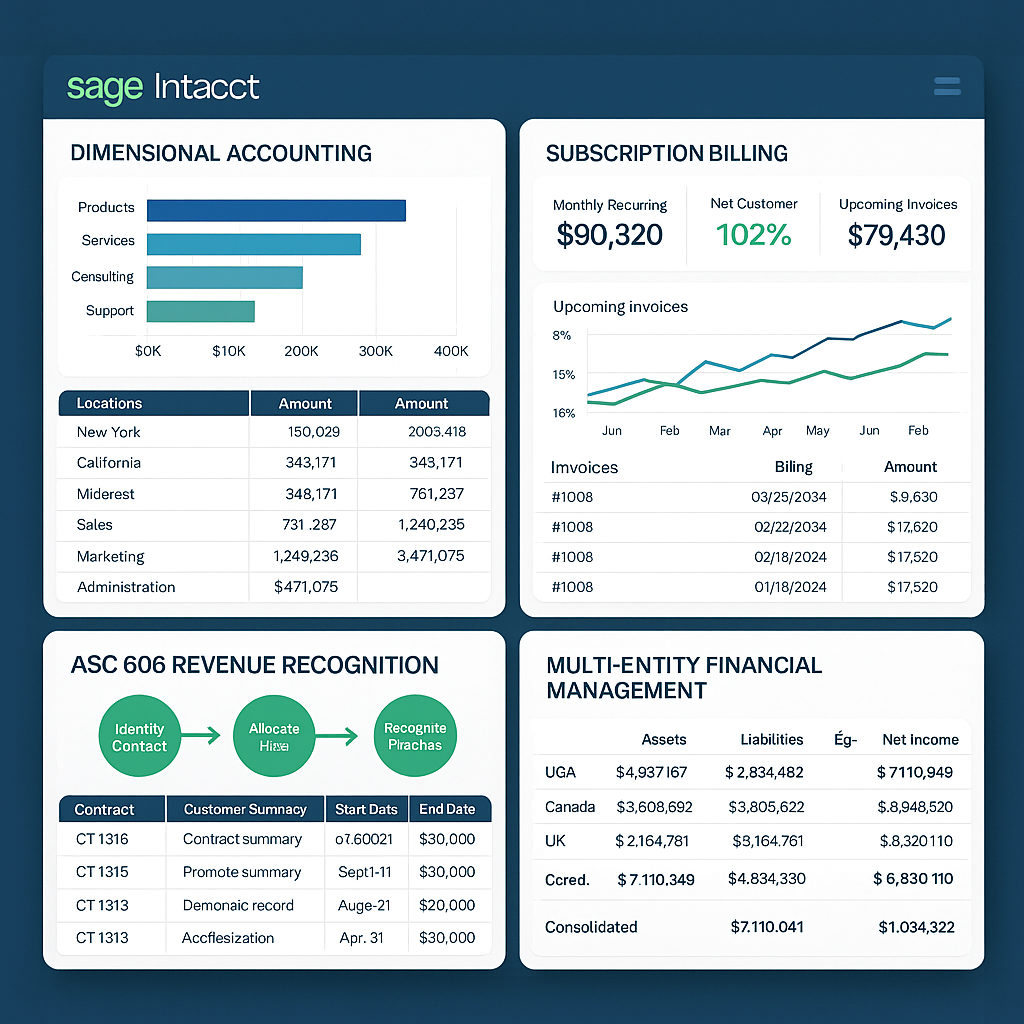
Table of Contents
The world of Enterprise Resource Planning (ERP) is often dominated by giants like Oracle NetSuite and SAP. While these systems offer comprehensive solutions, a perspective forged through years of navigating real-world enterprise integrations suggests that specialized, best-of-breed platforms can provide a significant strategic advantage.
Sage Intacct has carved out a powerful niche. It focuses intently on the needs of service-based and digital-native businesses, particularly those driven by subscription models. Its architecture isn’t just “cloud-enabled”; it was born in the cloud. It was designed from the ground up for the complexities of modern financial management.
Dimensional Accounting: The Core Differentiator
What truly sets Sage Intacct apart? It’s the platform’s core design philosophy. Insights distilled from numerous complex system deployments indicate that traditional, chart of accounts-centric ERPs often struggle to provide the granular, real-time insights required by SaaS companies. They can feel rigid and demand cumbersome workarounds.
Sage Intacct’s answer is dimensional accounting. Instead of relying on a sprawling, segmented chart of accounts, it uses dimensions (tags like department, project, location, or any other business driver) to categorize transactions.
This approach transforms financial reporting from a static, historical exercise into a dynamic, analytical capability. It allows finance leaders to slice and dice data effortlessly. They can answer critical business questions on the fly without needing custom reports for every new query.
This architectural choice has profound implications. This is especially true for organizations that have outgrown simpler accounting software but don’t require the full operational breadth (like manufacturing or complex inventory) of an all-encompassing ERP.
For businesses in software, professional services, and non-profits, the financial engine is the heart of the enterprise.
Sage Intacct’s focus on robust, multi-entity and multi-currency financial management, combined with its dimensional reporting, provides a level of clarity and control. This level of control is often overkill in larger, more operationally focused ERPs.
Revenue Recognition and Subscription Billing Excellence
Another key area where Sage Intacct shines is its handling of revenue recognition and subscription billing. The platform’s contracts module is a powerful tool designed specifically to automate compliance with ASC 606.
Longitudinal data and field-tested perspectives highlight that managing recurring revenue, contract modifications, and complex billing schedules can be a significant operational drag. Sage Intacct automates these processes, reducing manual effort and minimizing compliance risk.
It effectively creates a single source of truth for the entire contract lifecycle, from billing and revenue recognition to forecasting and renewals. This isn’t an add-on; it’s a core competency.
Automated Revenue Recognition and Compliance Management handles complex revenue scenarios including variable consideration, contract modifications, performance obligation identification, and multi-element arrangements while maintaining complete audit trails and supporting documentation required for financial statement preparation and regulatory compliance.
Subscription Lifecycle Management and Recurring Billing provides comprehensive capabilities for managing subscription plans, pricing tiers, usage-based billing, proration calculations, and renewal processes while integrating seamlessly with customer relationship management and sales systems to support end-to-end subscription business operations.
Advanced Financial Forecasting and Metrics Tracking enables subscription businesses to monitor key performance indicators including monthly recurring revenue, customer acquisition costs, churn rates, and lifetime value while providing predictive analytics that support strategic planning and investor reporting requirements.
However, no system is without its trade-offs. Organizations with heavy manufacturing or supply chain requirements might find Sage Intacct lacking compared to more comprehensive ERPs.
The platform’s strength is its focused, best-in-class financial management. It thrives on integration with other specialized systems (like a dedicated CRM or HRIS) rather than trying to be an all-in-one solution.
This composable approach, facilitated by a robust API, is increasingly favored by agile enterprises that want to select the best tool for each job.
Implementation Strategy and Ecosystem Integration
Integration Architecture and Ecosystem Connectivity enables Sage Intacct to serve as the financial backbone within complex technology ecosystems, connecting seamlessly with CRM platforms, business intelligence tools, payroll systems, and industry-specific applications through pre-built connectors, RESTful APIs, and middleware platforms that ensure data consistency and workflow automation.
Implementation Methodology and Best Practices leverage proven frameworks for system deployment, data migration, user training, and change management that minimize implementation risk while ensuring rapid time-to-value for organizations transitioning from legacy accounting systems or scaling from simpler financial management solutions.
Strategic Competitive Positioning and Market Differentiation positions Sage Intacct as the optimal choice for service-based organizations, technology companies, and subscription businesses that require sophisticated financial management capabilities without the complexity and overhead associated with traditional manufacturing-focused ERP implementations.
For the right organization, Sage Intacct isn’t just an accounting system; it’s a strategic asset. It provides the financial visibility and operational efficiency needed to scale a service-based business effectively.
Advanced Capabilities and Future-Ready Architecture
Cloud-Native Design and Scalability ensures that Sage Intacct can support organizational growth from startup through enterprise scale while maintaining consistent performance, security standards, and feature availability without requiring infrastructure investments or technical upgrades that burden internal IT resources.
Business Intelligence and Advanced Analytics provide embedded reporting, dashboard creation, and analytical capabilities that enable finance teams to generate sophisticated insights, perform scenario analysis, and support strategic decision-making without requiring separate business intelligence platforms or specialized analytical tools.
Regulatory Compliance and Audit Support encompasses comprehensive capabilities for supporting financial audits, regulatory reporting, internal controls documentation, and compliance monitoring across multiple jurisdictions and accounting standards while maintaining the detailed transaction history and supporting documentation required for external reporting.
It’s a prime example of how a focused, well-architected solution can outperform a generalist one. For a deeper discussion on system selection, feel free to connect with me on LinkedIn.